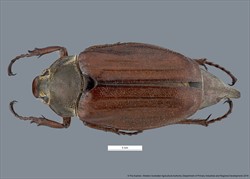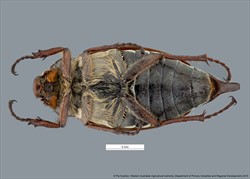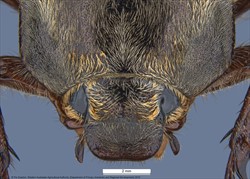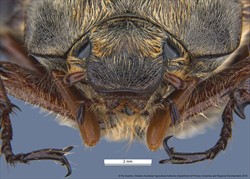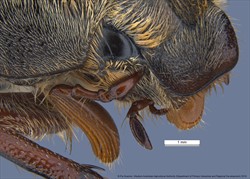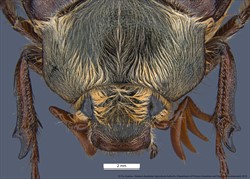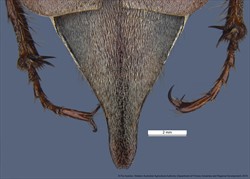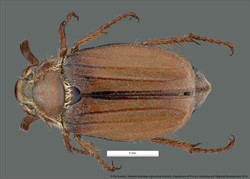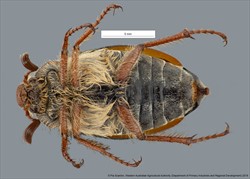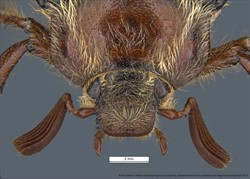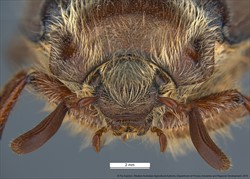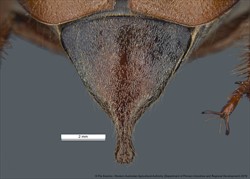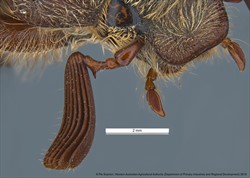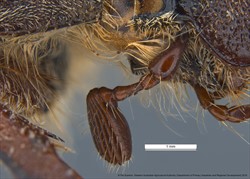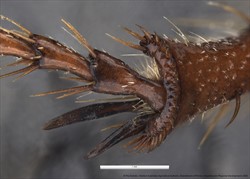Sub family: Melolonthinae / Tribe: Melolonthini / Genus: Melolontha
Fact Sheet
Melolontha Fabricius, 1775
Large cylindrical beetles, body length 20-34mm. Body covered in short decumbent grey or brownish setae. Body colouration: head, pronotum and abdomen black or brown, elytra light yellowish brown to dark reddish brown, rarely light olive green. Legs reddish brown. The sides of the abdomen with triangular white patches of setae on each segment. Patches of scale like setae can be present on the head, pronotum and elytra. Clypeus with apex subquadrate and slightly emarginate. Labrum located under clypeus, clearly separated and deeply incised medially, commonly with medially directed setae on each lobe. Antennae with 10 segments. Males with a 7-segmented elongated club. Females with a shorter 6-segmented club. Pygidium significantly extended posteriorly. Mesometasternal process developed. Elytral costae well developed. Foretibia tridentate. Mid and hind tarsal claws with a basal tooth.
Both of the species detailed here are significant orchard pests. M. melolontha is also a significant pest of horticultural crops, while M. hippocastani is a pest of closed forests where it may cause extensive damage in young plantations. Along with M. melolontha having been recorded damaging Eucalyptus leaves, there are records that an otherwise non-pestiferous species, Melolontha papposa larvae can feed on the roots of Eucalyptus.
Adults lay their eggs in the soil. The emerging C-shaped larvae first feed on the thin roots and later with maturity on increasingly thick roots. This can occasionally cause the death of trees, even those that are old and otherwise healthy. Their development time is dependent on the climate and can vary from three to five years.
The foliage feeding of adults may lead to the partial or complete skeletonising of mature trees. In the case of young trees, the feeding damage of larvae followed by the foliage feeding of the adults may lead to large-scale tree loss. Large numbers of larvae in the last developmental stage may attract mammal predators, such as feral pigs, causing secondary damage when searching for larvae.
Melolontha are present throughout the Palearctic and Oriental regions. The Genus is absent from Australia.
Detailed Wikipedia page: https://en.wikipedia.org/wiki/Cockchafer#Taxonomy
CABI Datasheet: https://www.cabi.org/isc/datasheet/33326
UK Beetles: https://www.ukbeetles.co.uk/melolontha-hippocastani
Balas, G. és Saringer, G.Y. 1984. Kertészeti kártevők. 2. kiadás. Akadémiai Kiadó, Budapest 1069pp.
Jones, F.G.W., Jones, M.G. 1984. Pests of field crops. Ed. 3. 392 pp.
van Emden, F.I. 1941. Larvae of British beetles. II. A key to the British Lamellicornia larvae. Entomologist's Monthly Magazine, 77:117-127, 181-192.
Vlug, H.J. 1996. Occurrence and biocontrol of grass grubs, especially of Melolontha melolontha. Bulletin OILB/SROP, 19(2):35-36.

